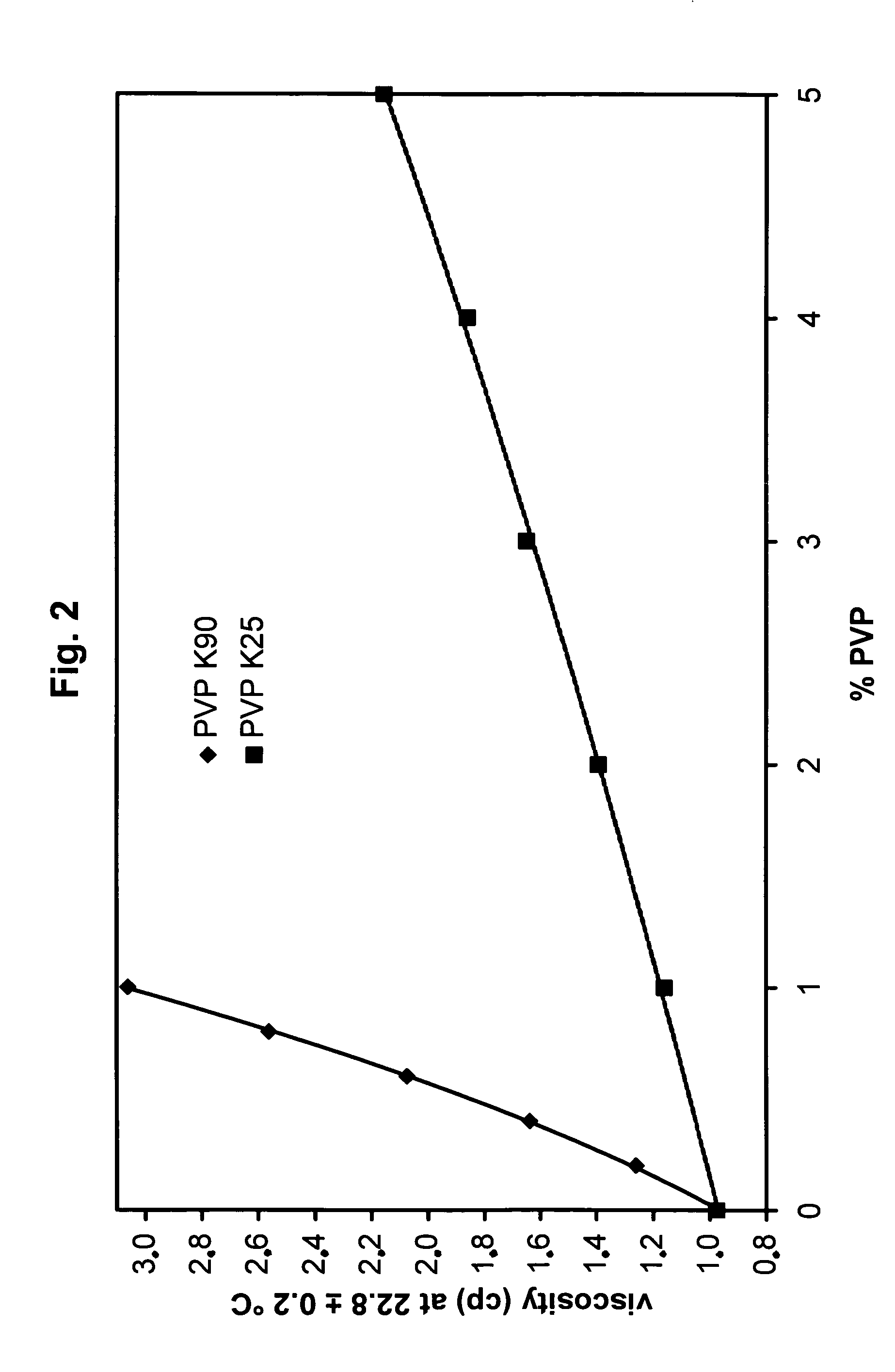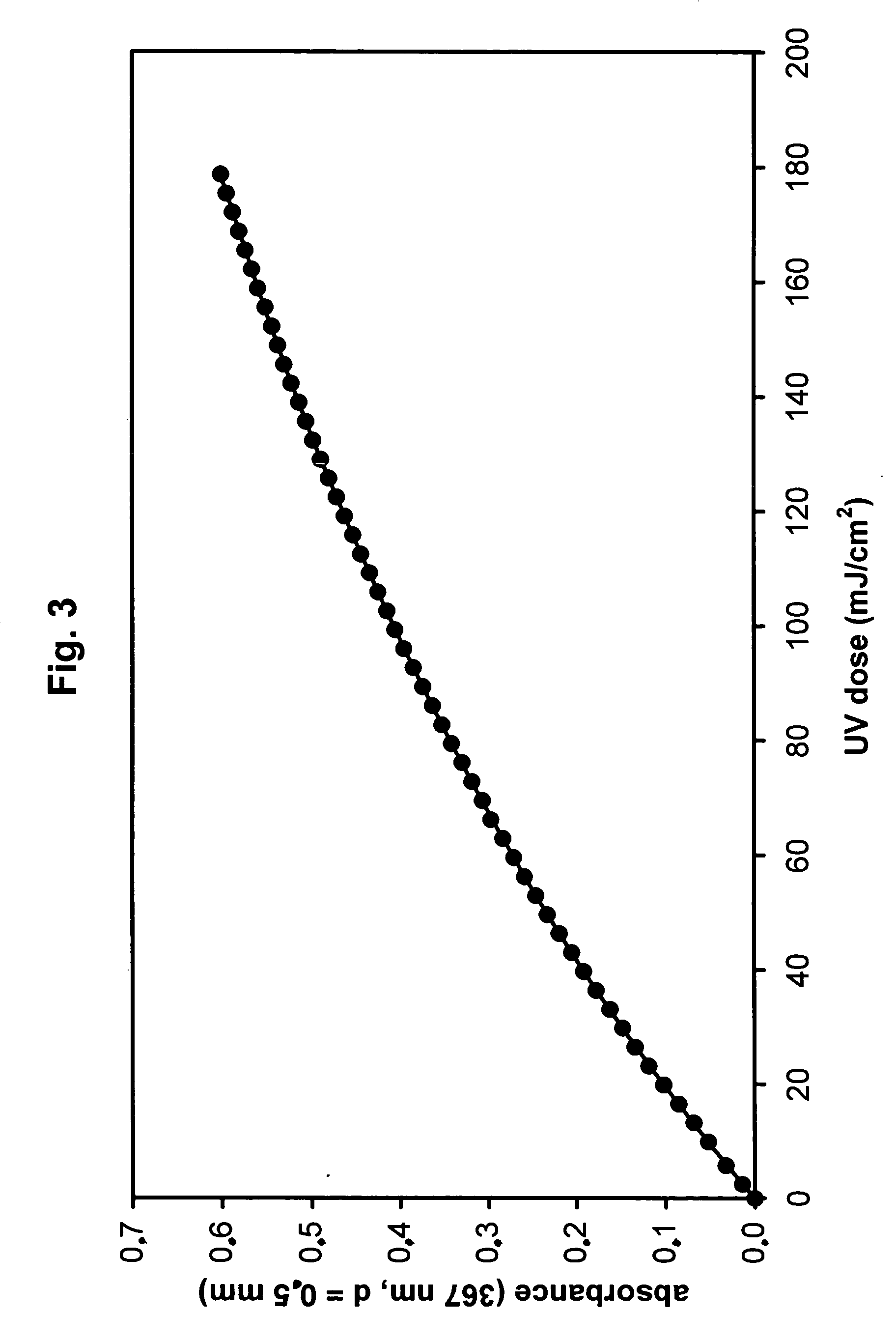Methods for the inactivation of microorganisms in biological fluids, flow through reactors and methods of controlling the light sum dose to effectively inactivate microorganisms in batch reactors
a technology of biological fluids and flow through reactors, applied in material analysis, material analysis using wave/particle radiation, instruments, etc., can solve the problems of iodide solution neither proposed nor done, and the design and scale-up of flow-through reactors is affected
- Summary
- Abstract
- Description
- Claims
- Application Information
AI Technical Summary
Benefits of technology
Problems solved by technology
Method used
Image
Examples
example 1
Absorption Coefficients of the Iodide / Iodate Actinometer Solution at High Dilution and Dosimetric Response of the Iodide / Iodate Actinometer Solutions
[0164] A solution containing 0.24 M KI and 0.04 M KIO3 in 0.01 M borate buffer, pH=9.25, was diluted 0.2-, 0.4-, 0.6- and 0.8-fold with 0.01 M borate buffer and the absorption measured in a 0.1 mm cuvette. FIG. 1 shows that the absorption coefficient depends in a linear ratio (a253.7=69 / cm x dilution factor) on the concentration.
[0165] Solutions containing 10 g polyvinylpyrrolidone K90 (PVP K90; average molar mass 360000 Da) in 1 L 0.01 M and 50 g PVP K25 (average molar mass 29000 Da) in 0.1 M borate buffer were diluted 0.2-, 0.4-, 0.6-, 0.8- fold in the corresponding buffer and the viscosity of the dilutions and the buffer were measured in a Schott 0.40 mm Ubbelohde capillary viscosimeter thermostated at 22.8° C. It can be seen from FIG. 2 that the viscosity increases with the concentration in a non-linear ratio.
example 2
Determination of the Irradiation Dose Effective in a Helical Flow-Through-Reactor
[0167] A floating immersion lamp for water tank UV disinfection (Microfloat 1 / 0, Aqua Concept GmbH Karlsruhe, Germany) equipped with an 11 W UV-C lamp in a 23 mm diameter envelope tube was mounted upside down and a 17.5-cm long fluoropolymer coil with a coil diameter of ⅞ inch (2.22 cm), 5-mm tube diameter and 0.63-mm wall thickness (manufactured by Markel Corp., Plymouth Meeting, Pa., USA, from Hyflon MFA produced by Solvay Solexis S. p. A., Bollate, Italy) was wrapped tightly around the lamp so that the 15 cm-illumination length was fully used by the coil. A Dr. Gröbel UV-Elektronik RM-12 Radiometer with a daylight-blind UVC-TLB sensor mounted at the middle of the coil was used to check the lamp intensity when the coil was rinsed with deionized water before the start and after the end of the dosimetry measurement. Using an Ismatec BVP peristaltic pump with a ISM719 three-roller pump head and silicon ...
example 3
Irradiation of Human Serum Albumin and a1-antitrypsin for Virus Inactivation in the MFA Coil Based on Chemical Dosimetry and Biodosimetry
[0169] Human serum albumin (20%) was diluted with 20 mM phosphate-buffered 0.15 M NaCl (phosphate-buffered saline, PBS) and bacteriophage Phi-X 174 lysate (˜1×109 plaque-forming units (PFU) / mL) added in a 1:100 (v / v) spiking ratio to obtain a protein solution with an absorption coefficient of a253,7=7.5 / cm and a viscosity of 1.05 cp. The solution was pumped through the MFA coil as described in Example 2. The lamp intensity was measured as in Example 2 (with an average intensity of 11.40 mW / cm2). Phi-X 174 titers of 0.9 mL sample solution were determined after serial decadic dilution by titration on the host bacteria. The inactivation rate was calculated from petri dishes having at least 10 up to 200 lytic plaques. The applied doses were corrected for the radiometric intensity (irradiation / dosimetry) ratio.
TABLE 2mL / minlog10 pfu Phi-X 174 / mLUV do...
PUM
| Property | Measurement | Unit |
|---|---|---|
| wavelengths | aaaaa | aaaaa |
| wavelengths | aaaaa | aaaaa |
| wavelengths | aaaaa | aaaaa |
Abstract
Description
Claims
Application Information
 Login to View More
Login to View More - R&D
- Intellectual Property
- Life Sciences
- Materials
- Tech Scout
- Unparalleled Data Quality
- Higher Quality Content
- 60% Fewer Hallucinations
Browse by: Latest US Patents, China's latest patents, Technical Efficacy Thesaurus, Application Domain, Technology Topic, Popular Technical Reports.
© 2025 PatSnap. All rights reserved.Legal|Privacy policy|Modern Slavery Act Transparency Statement|Sitemap|About US| Contact US: help@patsnap.com



